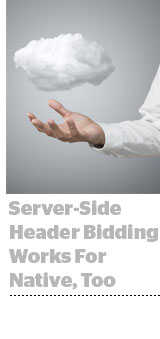 TripleLift is throwing its hat into the server-side header bidding ring.
TripleLift is throwing its hat into the server-side header bidding ring.
On Tuesday, it rolled out its wrapper, Apex, which lets publishers bring in demand for their in-feed native ad placements.
TripleLift will run a first-price auction among all participating partners, a shift from the OpenRTB spec of a second-price auction that could result in higher payouts for publishers.
TripleLift co-founder Ari Lewine said this auction setup will allow a publisher’s native ad partners to better compete for in-feed placements. Since many publishers require in-feed ads to compete against their own branded content campaigns running in their ad servers, bidding at a higher CPM will increase the chance of the ad winning the slot.
While Apex could incorporate demand from Facebook, Twitter, Nativo, Sharethrough, content recommendation engines and outstream video, none of those partners have signed on yet – which could mean Apex never gets off the ground (as happened with OpenX Meta).
Lewine said publishers who want to use the product, like Intermarkets and The Guardian, are spearheading conversations with their own native ad partners to encourage them to join.
And Lewine predicts the native ad ecosystem will work together better than the banner ad-focused SSPs.
“Our goal is to build a market, versus defend our market share,” he said. “Because the native ad ecosystem has less legacy holdup, I’m optimistic it will happen easier than in the banner ad space.”
Apex will work in parallel with a publisher’s server-side header bidding solutions for banner ads. Lewine noted publishers are building those two ad stacks separately.
While TripleLift integrates with all the major client-side header bidding wrappers,
Lewine said that setup makes it difficult for publishers to control what ad units end up in the feed and on the right rail.
AdExchanger Daily
Get our editors’ roundup delivered to your inbox every weekday.
Daily Roundup
He said Apex will give publishers more oversight around which ads show up in their feeds. Plus, it supports native ad templates, making it easier for publishers to control the look of their native ad placements.
Lewine predicts adoption could be swift, citing how fast publishers implemented client-side header bidding.
“Header bidding adoption in the past 12 months has been unprecedented,” Lewine said. “Publishers are regaining control of their ad businesses. They will earn more money, and users will win because the ads will look better with less latency.”













